We left Oswego on a morning that was forecast to be good weather and calm seas on Lake Ontario. Unfortunately, the passing weather system had roiled the waters enough that they had not quite settled down. It also created quite a significant morning fog. We went through the last lock and then pulled in to the marina dock for a pumpout and to wait for visibility to improve. After an hour we had about 1 mile of visibility, so we set off. Instead of the usual display of just the chart on the chartplotter, Dick activated the radar and set up a split screen. We were following 3 other loopers, all with different destinations, but we could see them easily on the radar screen. The light chop was uncomfortable at our regular cruising speed of 7 knots, so we gave her a fast run for a couple of hours. At 18 knots the boat rides nicely over the chop, and we soon left the other boats behind.

We arrived in Sackets Harbour, and proceeded to Navy Point Marina. Here we could really see the extent of the high water that this spring has brought to Lake Ontario and the 1000 Islands. The large covered boat dock was entirely under water, as was the dock next to the one we were assigned. Our beam meant that, as often happens, we were on the fuel dock, but it was not a problem because power was turned off to all the docks in the marina. If you look at the picture you can see where the other dock is, with the power pedestals standing up above the water. Unfortunately, any wake will almost certainly have washed water into the outlets on those pedestals, and I gather they are very difficult to dry out once that happens. So it will be a difficult summer for any marina with fixed (as opposed to floating) docks this year.

We loved Sackets Harbor, and wished we had planned to stay a bit longer. The town was founded in the mid-1700s, and the main street has some beautifully preserved and tended homes. The town takes good care of their heritage, and we enjoyed the beautiful municipal plantings that complimented the tree lined streets. The village was the site of a major Navy shipyard, built specifically for the War of 1812. The shipyard and a naval station continued to bring prosperity through the 19th century, and Sackets Harbor was an important Great Lakes port. By the early 20th century it was also a destination for families taking long summer vacations from the major cities of the Great Lakes and New York.
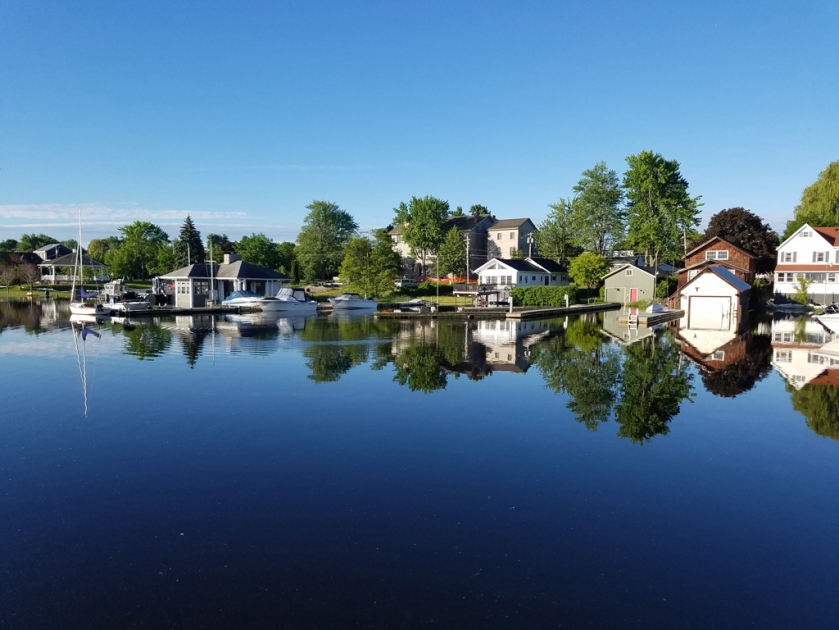
While Dick went off for his usual whirlwind walking tour of the village, I enjoyed people watching and listening to the live music floating across the water from one of the many waterfront restaurants. A local eatery called Tin Pan Galley had been highly recommended, and we were disappointed to discover that they are not open on Sundays. However, our spirits lifted when we were told that they had decided to open that day, in honour of Father’s Day, and they had a table for us. It was one of the best meals we have had so far this trip, enhanced by the live music. The musician played a variety of instruments, and mostly folk and light rock of the 60’s and 70’s, so we thoroughly enjoyed ourselves.
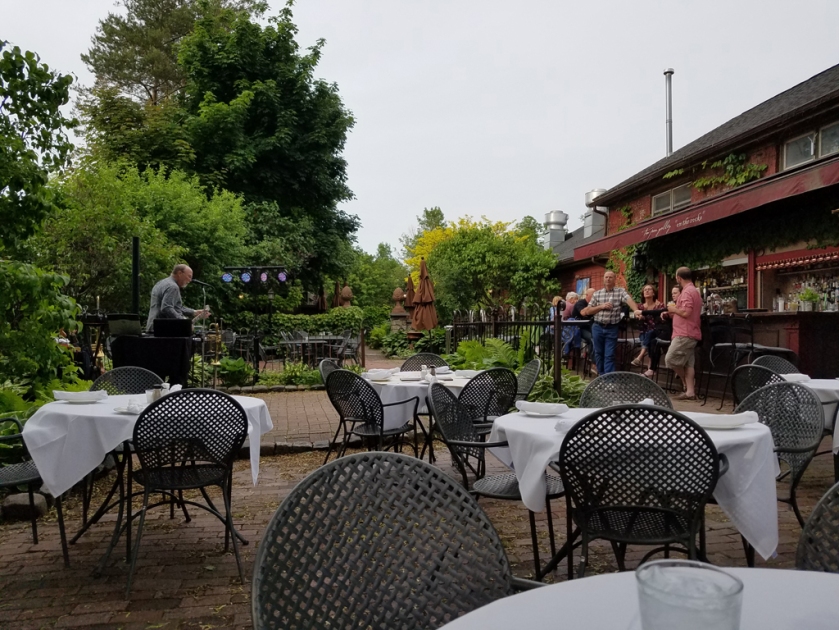

The next morning we set off for Cape Vincent. Dick had intended to anchor behind the village breakwater, knowing that the docks would be under water. We arrived to see that the breakwater is a favourite roosting spot for hundreds of birds, seagulls, cormorants, and even oyster catchers. While it would have been possible to tie up to the breakwater, and the birds would have flown off on our arrival, we also knew that they would return, and as soon as it got dark and quiet, they would avail themselves of the decks of Nine Lives. So, leaving aside the pitter patter of birdie feet across the deck all night, I asked Dick if he really wanted to clean all the resulting guano off the decks! Dick decided I was probably right, and we headed for Clayton a day early.
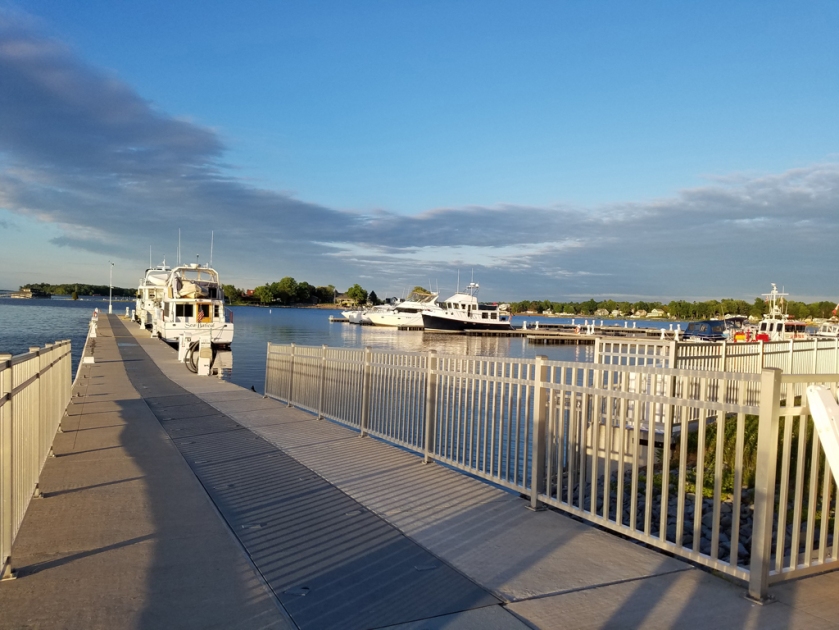
Clayton is another lovely St Lawrence village with a historic downtown, excellent shops and restaurants, and the main attraction, the outstanding Clayton Antique Boat Museum. We pottered around the shops, stocking up on local cheese, sausage, chocolate, and some lemon infused vinegar. Our visit to the boat museum was everything Dick had hoped. There are both in-water and dry sheds, with a huge variety of wooden boats of all sizes and vintages. We toured La Duchesse, an enormous houseboat built in 1903, and used for entertaining by George Boldt (more about him later). This is a beautifully restored barge type of houseboat. It has no engines, instead it was towed to its destination by a tug. In addition to running water and flush toilets, the two storey home boasts two wood burning fireplaces, servants’ quarters, a dining room, and a large salon with a stained glass dome above a piano. Impressive as the fireplaces were, we were told by the guide that the one time the owner tried to light the one in the dining room the flue didn’t work and the room filled with smoke! An open fireplace is perhaps not the best idea on a boat anyway.


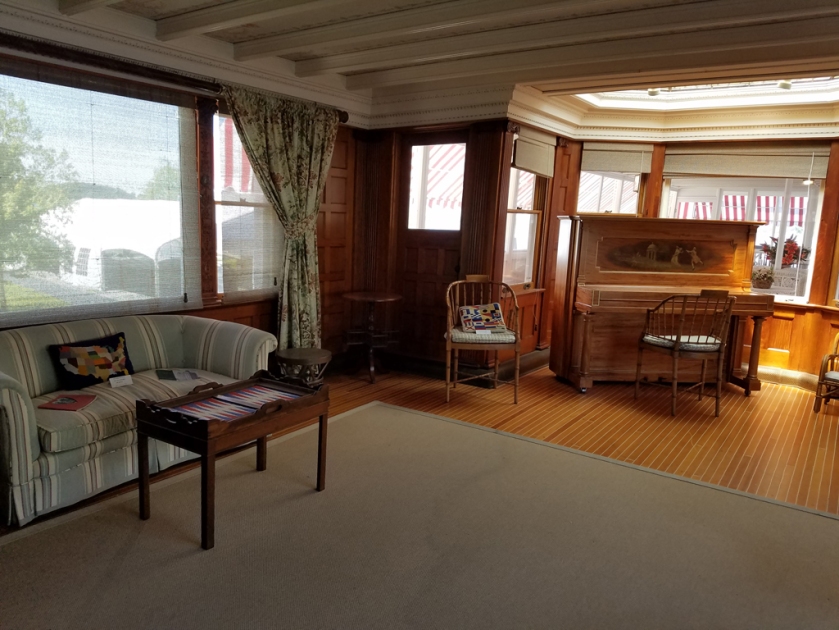

The rest of the museum was equally fascinating. One whole shed is devoted to canoes of all kinds, from the dugout through sailing canoes to contemporary fibreglass and other materials. Another shed shows the history of boat racing. An in-water shed even offers short tours on some of the historic craft. I found the whole experience quite nostalgic. In the 1960’s and 70’s my family had a cottage on a lake in southern Ontario. My Dad was very fond of boats, and at one point we had 7 of them. He built a sea flea, a plywood hydroplaning boat that my brother and I loved to zip around the lake at ridiculous speeds, creating a noise that today I would find extremely annoying! Dad was also persuaded to buy a classic mahogany boat, that he could parade majestically around the lake. He would have loved the museum!
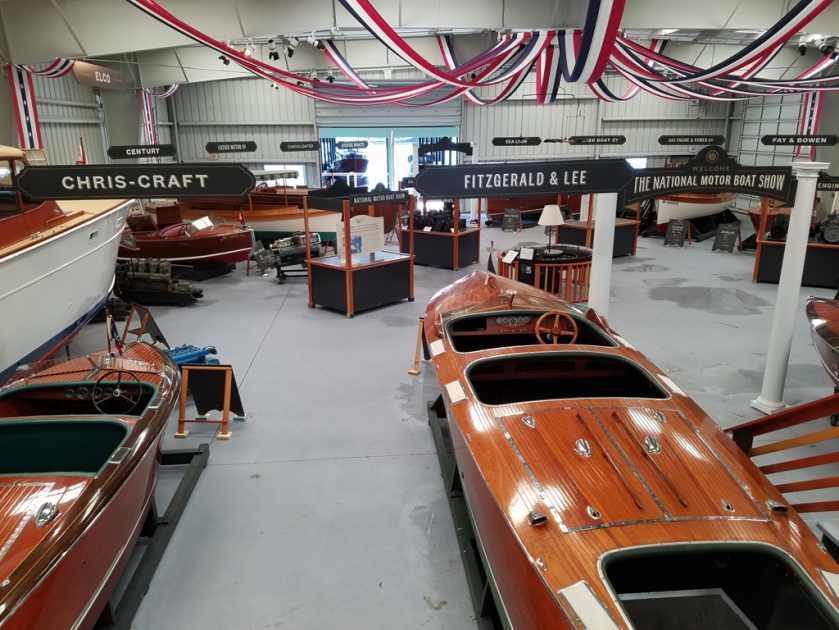
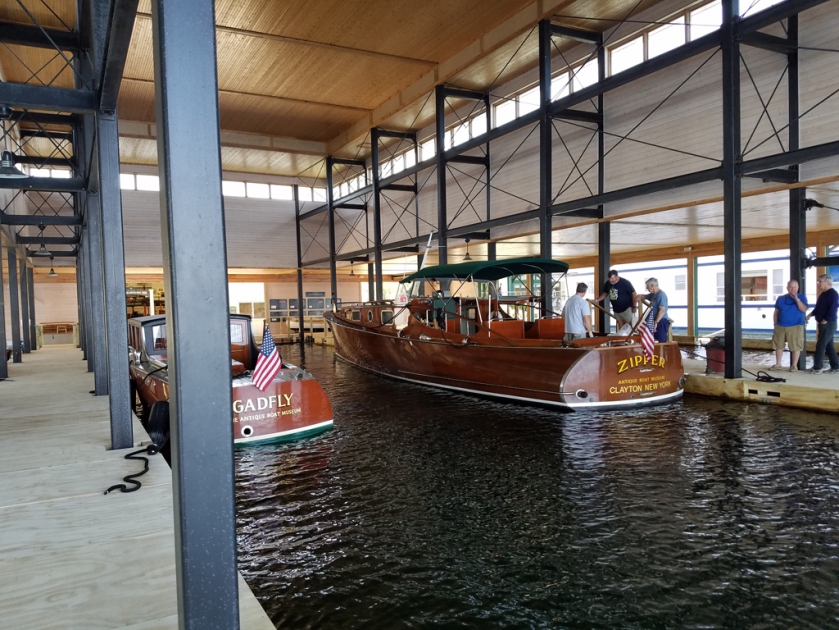

There were several Looper boats in the marina while we were there, and one evening the Thousand Islands Harbor Host and his wife brought their boat down for the evening and a convivial docktails get-together. Dick and I had cleaned Nine Lives inside and out that day, and it was a very pleasant evening sitting out on the foredeck watching the river, chatting with new friends, and nibbling on a charcuterie platter.
The next day we made the fairly short trip downriver to Alexandria Bay. Here the municipal dock has had a second dock built on top, so it is still possible to tie up there. There are two marinas beside the Town docks, both are under water, but that has not stopped them being open for business. Fuel is dispensed by dockhands wearing wellington boots! Our visit coincided with a biker’s meet in the town. One might once have been concerned, but I was reminded of the comment from my neighbour in our UK house in Yorkshire. Hawes is a mecca for bikers, especially on weekends, as they love tearing along the winding, hilly roads of the Dales. John told me, “They won’t bother you, they’re all old men, young ones can’t afford those bikes!” This seemed to be true of the bikers gathered in Alexandria Bay, many of whom took a stroll along the town dock and looked at the boats.
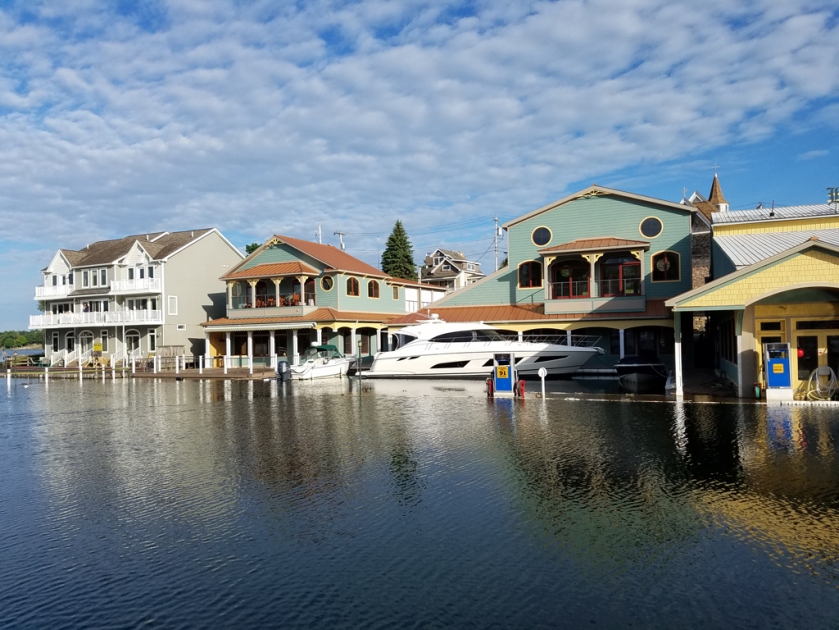


From Alexandria Bay we took the first shuttle of the day to Boldt Castle. Normally we would have been able to go there in our own dinghy, but the public docks are under water and only tour boats are allowed to visit. We spent about two and a half hours wandering around the castle. Boldt Castle was built by George Boldt for his wife Louise. From his roots as a poor immigrant, he became wealthy as the owner of the Waldorf Astoria Hotel in New York. He and his wife bought Hart Island, changed the name (and even the shape of the island) to Heart Island, and lived in the existing house while construction and transformation of the island began. There are 3 interesting towers. The Alster Tower is sometimes called the Playhouse, and was supposedly intended for the Boldt children. The Power House is situated on a point and housed the electrical and pumping machinery, as well as apartments for the engineers. The Dove-Cote was the original structure on the island, containing a water tank and topped by an aviary where exotic fowl were housed (one presumes the tank was well covered…).

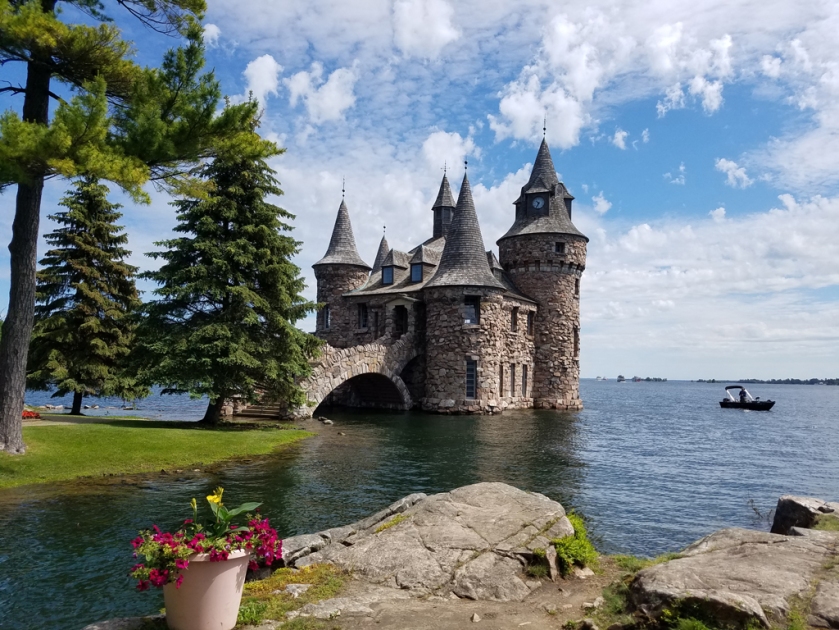
The magnificent main castle is certainly an exercise in conspicuous consumption and display of wealth. The castle was never completed or occupied. During the construction, Louise suddenly died, and the next day George sent a telegram halting all work. All the materials had been ordered and were stored in warehouses, as was some of the furniture, and even marble statuary for the gardens, but the construction never resumed and George never visited the island again. During WWII, the current owner of the castle allowed it to be stripped of iron, steel, and copper towards the war effort. Over forty thousand tons of materials were removed, not very carefully, contributing to the speed of the deterioration over the 73 years that the castle stood empty and unfinished. In 1977 the Thousand Islands Bridge Authority took over the castle, the island, and the nearby Yacht House, and began a program of restoration. We were very impressed with the care and quality of the workmanship. This is more than a restoration, the Authority is actually completing the castle construction, furnishing rooms as they are finished. It is a major attraction for the Thousand Islands, and contributes to the economy and tourism in the area. It is estimated that in addition to employing at least 600 people, the castle contributed nearly $40 million a year to the local economy.
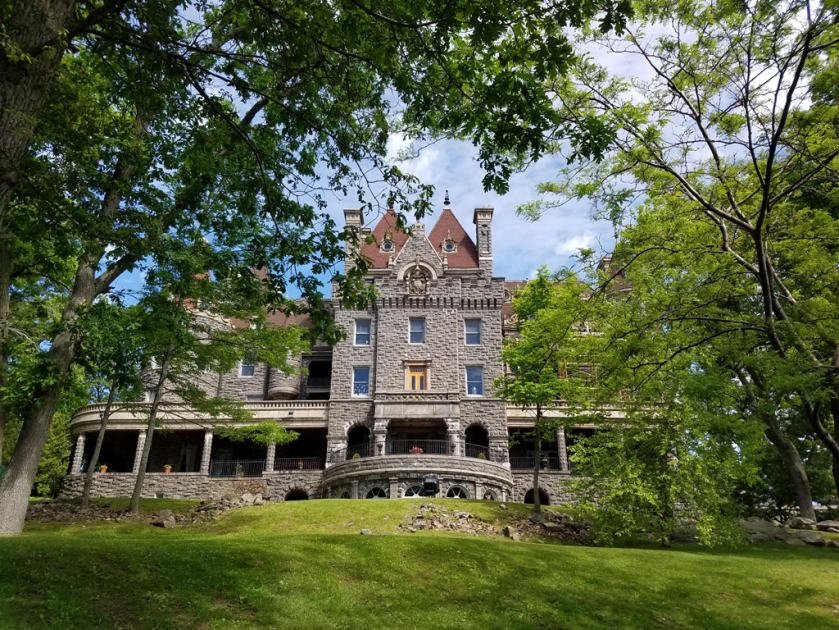
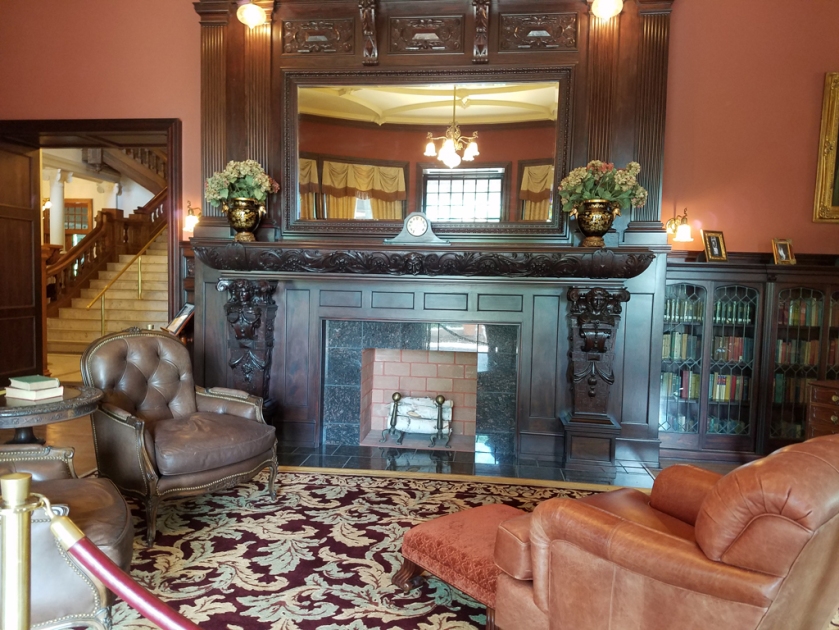
The next morning we set off before the local tour boats and circumnavigated the castle. We also tooled around the nearby bay, off Wellesley Island, home of some stunning summer and full time homes, and the exclusive Thousand Islands Yacht Club. We then headed north on the River towards Brockville, pausing to loop around Singer Castle on the way. We had hoped to dock, but a sign suggested that it was closed that day.

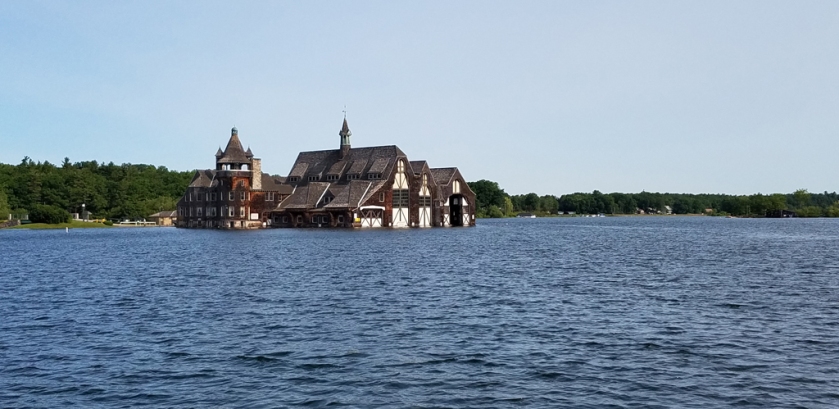

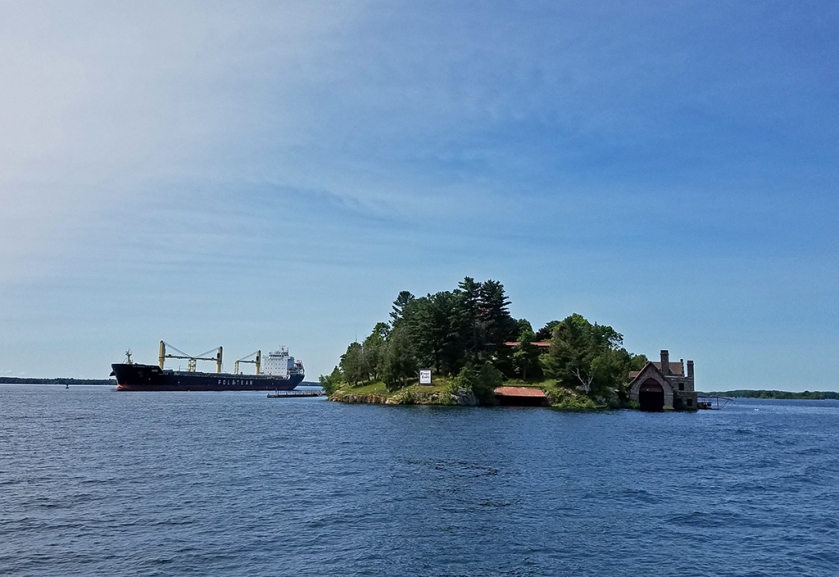

We had intended to stop in the small village of Morristown for the night, but on arrival the marina appeared to be deserted. Our reservation was made online, and there was no response to either radio hails or phone calls. The docks appeared to be in very poor condition, with metal sticking out and parts under water. We decided to see if we could dock in Brockville a day early. On arrival the first task was to contact Canada Border Protection and check in. Apart from a long wait on hold, it was a very easy process, sitting in comfort on the boat instead of the former requirement to stand at a pay phone! Dick was duly given the check-in number, and I was very glad he wrote it down and told me where he put it. A couple of days later two officers walked down the dock and asked me if we had checked in and to see that all-important number.

We stayed 4 nights in Brockville. This allowed time for local sightseeing and lunch with another Looper couple and the local Harbor Host. We met at a tearoom called Cosies, run by a couple who emigrated from England 20 years ago. Unusually (in my experience), they have not changed their offerings from traditional English fare. Their breakfast is exactly what one would be offered in any good B&B in England, complete with black pudding and baked beans, although the bacon is the American style strips, rather than English cut. For lunch they offer many very traditional English treats, including my absolute favourite prawns in Marie Rose sauce. For our non-English friends, this means small shrimp in a pink sauce made of mayonnaise and tomatoes. You can have it as an open-faced sandwich, or on an also traditional jacket potato (baked potato).
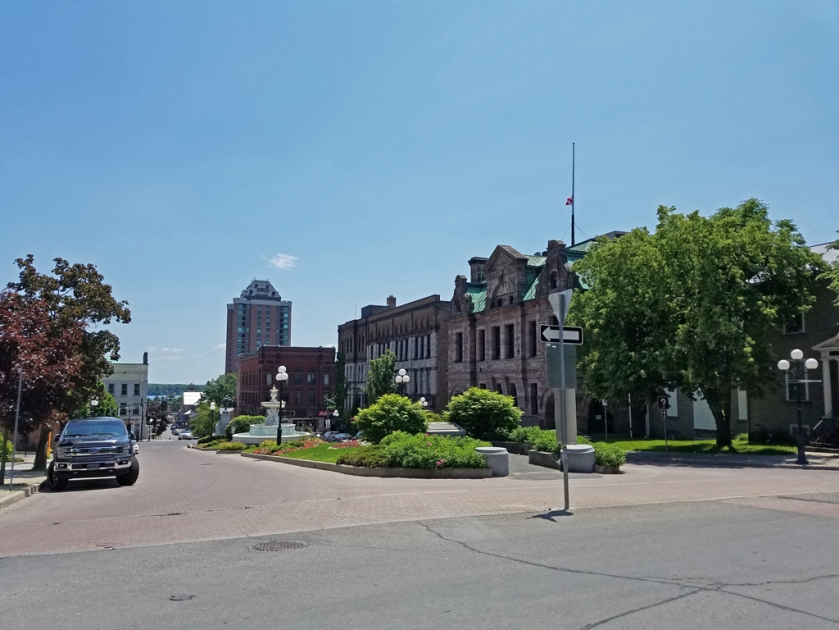
Dick took a train to Toronto, staying overnight at the Royal York Hotel, and then joining the annual reunion lunch of his former colleagues from Ingersoll Rand in the late 70’s. I enjoyed my couple of days with my own company, and took the opportunity for a major session with the washer dryer! I really enjoyed the people watching, as the marina is located on a spit of land that is a popular park for dog walkers, exercising, and visiting families. There is also a tour boat leaving from one of the docks, taking a 90-minute tour of the 1000 Islands. At one point I was surprised to be hailed by an Indian lady accompanied by her extended family (about 20 people). She asked where the 90-minute tour was going to take them. I politely sent her along to the tour office, and then realized that she had thought that Nine Lives was the tour boat!
I also enjoyed watching two tall ships that were on the docks. One was out in the river when we arrived, but the larger one was being fitted with spars and sails. I watched the young sailors hoist one of the spars, and then fit it to the mast. The next day they attached the sails, and then set off down the river. There is a tall ship meet and race this year, that will visit a number of the cities on the Great Lakes, and both the ships in Brockville are part of the event. I hope we have an opportunity at some point to see one under sail, although I suspect the timing won’t work for us.


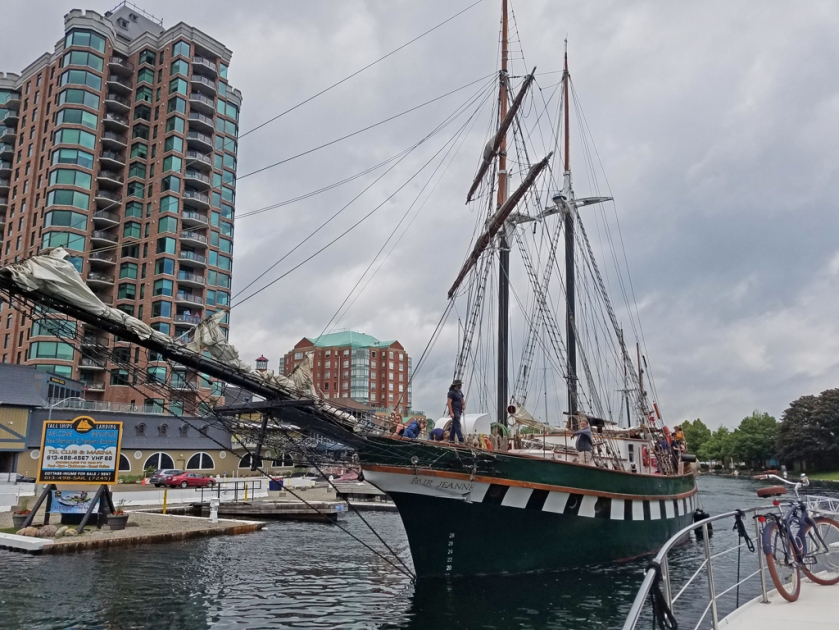

On the last evening I watched a sailing race out in the St Lawrence. At least 20 boats raced down the river with spinnakers flying in the evening light. An hour later they returned and I had a front row seat while they made hair raising turns just short of running aground on the submerged outer docks of the marina.
Our next destination was Gananoque. We enjoyed cruising back along the Canadian side of the St Lawrence, and were greeted on arrival at the dock by the local Harbor Host. The next evening we were entertained by him and his wife in their stunning condo on the harbour for cocktails and chat with them and two other Looper couples.
Another highlight of the trip so far was a 1-hour helicopter ride. We flew as far as Kingston, passing over Fort Henry, the city, Queen’s University and the Penitentary. Our route then took us across Wolfe Island and along the US side of the River as far as Singer Castle. The pilot pointed out the various sights, and also a number of wrecks that are visible from the air in the clear water of the river. It was a fantastic tour, finishing with a loop over the marina in Gananoque where we could see Nine Lives at dock beside another Looper catamaran.
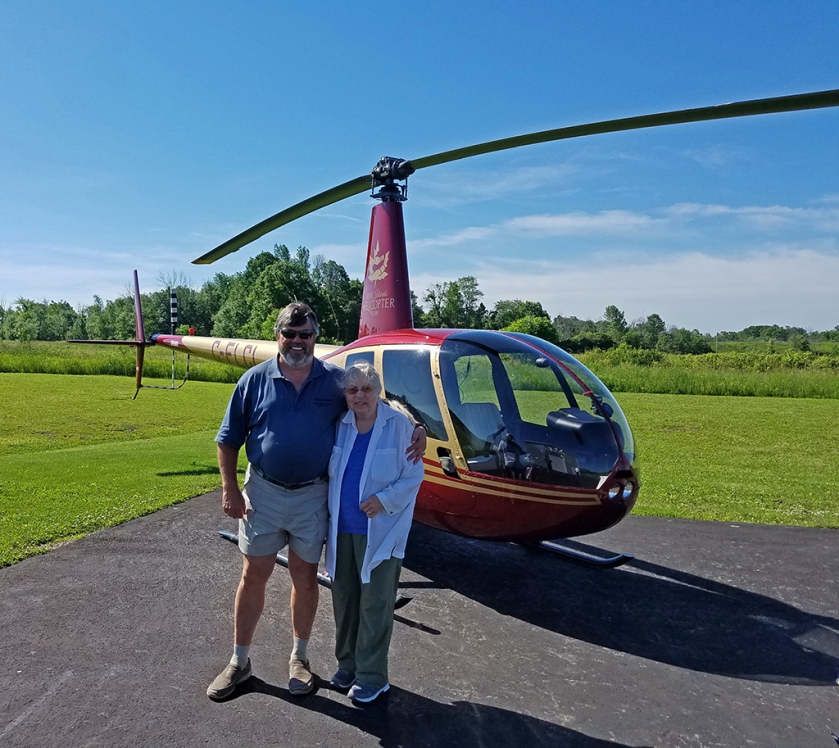
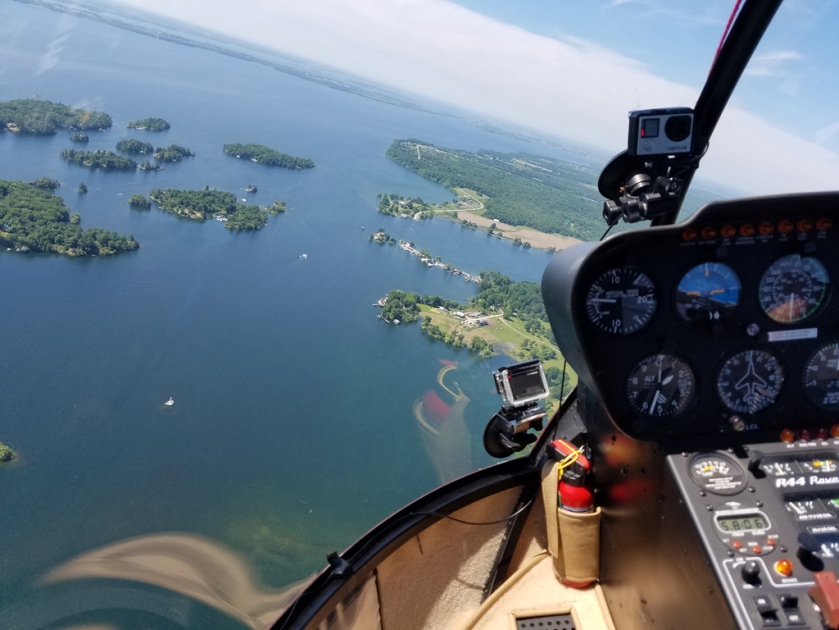

From Gananoque it is a short trip up the river to Kingston. We were too late to get in to any of the local marinas, especially as the weekend is a Canadian holiday and the traditional start of a great many summer festivals, fireworks, and of course boating. With the high water, many docks are unavailable, so transient space is limited even more than usual. We anchored in a bay disturbingly called Deadmans Bay, tucking in just before the Canadian Forces Yacht Club. There were long swells coming up the bay from the river and Lake Ontario, so it was rock and roll for most of the afternoon. Also, it was quite a boring place, with nothing much to see and no boats to watch. In the early evening the waves calmed down and the wind changed, and suddenly we were facing the opposite direction. We usually put out quite a lot of rode, so we were disturbed to find that we drifted right over a floating buoy. This buoy slid under and around the boat all night, banging on the hull and making it very difficult to sleep. Add to that, in the early evening there was first a tornado watch, followed by a squall watch, urging us to “take cover”. The next morning I couldn’t get out of there fast enough!
Because we left so early, we were able to arrive in the next bay over, called Navy Bay. The previous day it had been filled with a dinghy sailing race. We anchored well into the bay, and enjoyed a wonderful peaceful day with lots to watch. On one shore is Royal Military College (RMC), and as we watched a large group of cadets rig sailing dinghies and set out to race in the River. On the other shore we could see the ramparts of Fort Henry, and one of the Martello towers beside where we anchored. Later in the day another Looper boat arrived, followed by 5 sailboats. This was certainly the most anchoring company we have had in years!
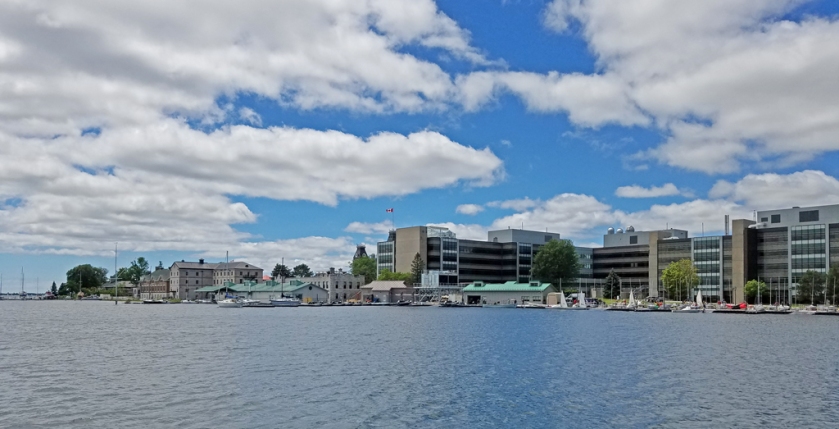

We enjoy listening to the “chatter” on the VHF radio when we are docked. I tell you, the young men who handle the radio for the huge Confederation Basin Marina deserve medals, or possibly sainthood! We listened to people calling in, many not using standard marine radio protocols and terminology. Some of what we assume are our American boating neighbours kept calling “Confederate Marina”, and one boater became quite frustrated when his calls to “Kingston Marina” went unanswered. Each boater is given very careful directions to find their slip, and about a third of them then get a subsequent call, “You are going the wrong way, please turn around and exit that channel and turn up the next one. Apparently, the dockhands in bright red t-shirts are not easily seen…
Our next destination is Trentport, via Bath and Picton, and then after a few days pause we will head up the Trent Severn Waterway towards Georgian Bay.



Awesome Louise and Dick…thanks. Just one small correction Gananoque to Kingston is up river. If you are in Peterborough before the 9th give us a call. We’re heading out toward Georgian Bay on July 9 hoping to be at Port of Orillia on July 14.
LikeLiked by 1 person
Corrected, thanks! We hope to catch up to you, or perhaps meet you on your return journey.
LikeLiked by 1 person
Louise/Dick – Thank you for these posts on your adventures. I enjoyed reading them as well as the excellent photography. Happy Sailing!
LikeLiked by 1 person